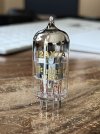Many look for "warm sound" (added even harmonics) - opposite to many SS amps that produce TIM distortions (overshoot in time domain) resulting in added unpleasant higher order odd harmonics (3th harmonic is still euphonic). TIM is produced when deep negative feedback is used. NFB is wonderful, reducing THD, IMD, output impedance and increasing bandwidth. It is possible to design SS amp with deep NFB free of TIM, but bandwidth would have to be reduced at the input, to one amp had before feedback was applied (likely poor). Unfortunately it doesn't look good in specifications, while TIM is undetectable with typical sinewave measurement (tempting to use a lot of NFB). The other approach is to create feedback that is non-recursive using additional error amplifier, that corrects output (instead of feeding signal back to the input of the same amp). That's how it is done in my Benchmark AHB2 amp, that has two parallel output stages - one one for the signal and one for the error.
Any added distortion would make instruments sound false. Clarinet, for instance, has such unique sound because it produces only odd harmonics (complete lack of even harmonics). Passing it thru "warm sounding" amp will change its sound. It might still sound nice (or even nicer), but it won't be original clarinet sound. Piano overtones are stretched. Overtones of given key is not at the double frequency of the octave higher key, but a little bit higher. To avoid beat between such keys higher keys are tuned higher - to overtone of the lower key and not to double frequency. Tuning person plays first key and then stretches octave higher key frequency to stop the beat. After all this is done to avoid beat people play it thru overly warm amps, that add harmonics, that beat with overtones.
When people get used to added harmonics (or distortion) anything clean will sound to them analytical/sterile. Some even claimed that amp "removed" harmonics from musical material (impossible unless bandwidth is inadequate). Distortion adds dynamics, pretty much like distorted electric guitar vs clean Jazz guitar at the same level. Warm sound is not a virtue to me - it is distortion of the sound.

